Bulletin – March 2010 Recent Trends in Australian Banks' Bond Issuance
- Download the article 173KB
Abstract
Bonds are an important source of funding for Australian banks. While the financial crisis greatly affected capital markets, overall Australian banks retained good access to the bond market, with a sharp increase in the volume of bonds issued over the past couple of years. This reflected their sound balance sheets as well as the introduction of the Government guarantee which aided banks' access to bond markets at the height of the crisis. While price differentials continued to influence banks' decisions about where to issue bonds, during the crisis other factors increased in importance.
Introduction
Bonds account for almost one-quarter of Australian banks' total funding, with around three-quarters of the stock of bonds outstanding issued offshore.[1] While the composition of banks' funding had been fairly stable prior to the financial crisis, since then the share of bonds in overall funding has increased by a couple of percentage points as banks have sought to attract more stable and longer-term sources of funding. This article discusses the changes in the patterns of Australian banks' bond issuance, as well as the impact of the financial market turbulence on bond pricing and maturities.
Historically, Australian banks have issued bonds in a range of currencies and markets to take advantage of pricing differences across markets and for funding diversification. Australian banks have issued a large volume of bonds over the past couple of years, in part to lengthen the average maturity of their wholesale liabilities and to improve stability in their funding base. Their ability to tap capital market funding was supported by their relatively strong balance sheets and, at the peak of the dislocation in markets, the introduction of the Government's Guarantee Scheme for Wholesale Funding (discussed in ‘The Australian Government Guarantee Scheme’ in this issue of the Bulletin).[2]
The spread banks pay when issuing debt has increased substantially since mid 2007, but at the height of the crisis the increase in the spread was partly mitigated by the use of the Government guarantee. While minimising the overall cost of issuance continued to be an important determinant of where bonds were issued during the financial crisis, other factors – such as funding diversification, the ability to issue longer-maturity bonds and the capacity to raise larger volumes – increased in significance.
Patterns of Issuance
In general, the Australian banks, particularly the major banks, which account for three-quarters of banking assets in Australia, maintained good access to the bond market during the credit crisis. In part this reflects the Australian banks' sound balance sheets and profitability, which has made them attractive to investors, particularly relative to other global financial institutions.[3] The four large Australian banks are all rated AA, making them among the most highly rated banks globally by credit rating agencies. Despite their sound financial position, at the peak of the crisis the Australian major banks, like most banks globally, issued guaranteed long-term debt only (although they continued to issue unguaranteed short-term debt).
In the months immediately following the onset of the financial crisis in mid 2007, bank bond issuance continued at around the same pace as during previous years (Graph 1). Banks continued to be able to raise funds readily, albeit at a higher cost. However, other entities had difficulty accessing funds in capital markets. In particular, with securitisation markets closed, lenders such as mortgage originators which relied entirely on this market for funding were forced to slow their lending to households. As a result, the banks undertook an increased share of housing lending and provided more funding to non-bank lenders. At the same time, many companies which found tapping the bond market increasingly difficult or costly also turned to banks for funding. In part to fund this reintermediation, banks increased their bond issuance in early 2008. As it became more evident that the financial crisis would not be short-lived, the banks also issued bonds for precautionary purposes to get ahead on their funding plans. In the financial year 2007/08, bank bond issuance averaged $9 billion a month, compared with $6 billion a month in the previous year.
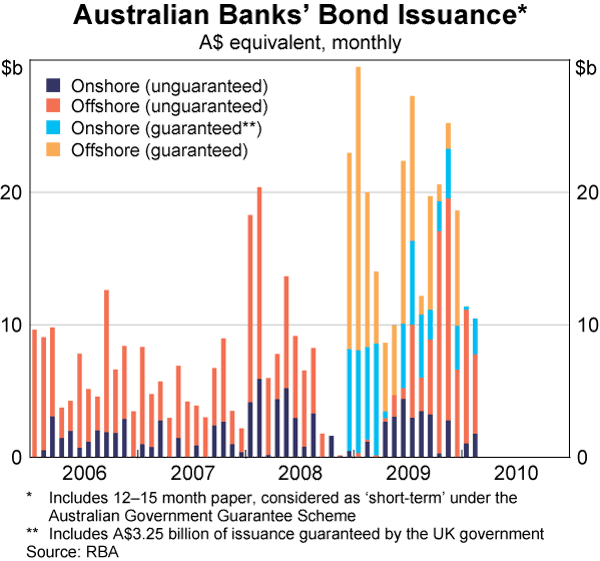
Bank bond issuance globally slowed sharply in September and October 2008, amid the renewed disruption to global credit markets following the failure of Lehman Brothers and the near-bankruptcy of a number of financial institutions in the United States and Europe. Uncertainty about the health of the global financial system and a sharp increase in risk aversion led to a further intensification of tensions in credit markets. Reflecting this market dislocation and the announcement of similar schemes in other countries, the Australian Government announced in October of that year that it would offer a guarantee on bonds issued by eligible authorised deposit-taking institutions for a fee. In the months following this intensification of the crisis, there was virtually no demand globally for unguaranteed financial institution debt, particularly for terms greater than one year, and what little unguaranteed debt was issued globally was at exceptionally high spreads. During this period of greatest dislocation, the guarantee enabled Australian banks to issue larger volumes and at much longer terms than would have been possible in unguaranteed form. The large issuance volumes were possible because the guarantee made regular buyers of financial institutions' debt more comfortable with the risk (as the debt was afforded the Australian Government's AAA rating) and also broadened the investor base, by attracting investors whose mandate covered sovereign-guaranteed debt. Given the historically high spreads at the time, the guarantee substantially reduced the cost to financial institutions of issuing term debt.
As conditions improved, banks recommenced issuance of unguaranteed debt, although for some time guaranteed debt was still issued as it was cheaper (as discussed below) and there was investor demand specifically for the guaranteed debt. While only 15 per cent of bonds issued in the first half of 2009 were unguaranteed, that share increased to around 55 per cent in the second half of the year, rising to over 85 per cent so far in 2010.
The resurgence in unguaranteed issuance has almost entirely come from the major banks. Despite their ability to issue unguaranteed debt, there have been some guaranteed issues by major banks in recent months, notably December 2009. Typically these have been in response to reverse enquiries (investors approach the issuer, which avoids the costs associated with investor roadshows and marketing) and when they have been cost-effective and convenient. While the smaller, lower-rated Australian-owned banks have traditionally issued bonds only sporadically, they have yet to return to their previous volumes of unguaranteed issuance, and have used the guarantee to issue more bonds than they did prior to the crisis (Graph 2). Currently, around one-third of the stock of bank bonds outstanding is guaranteed by the Australian Government; as discussed in Schwartz (2010), the Guarantee Scheme is scheduled to close to new borrowing at the end of March 2010.
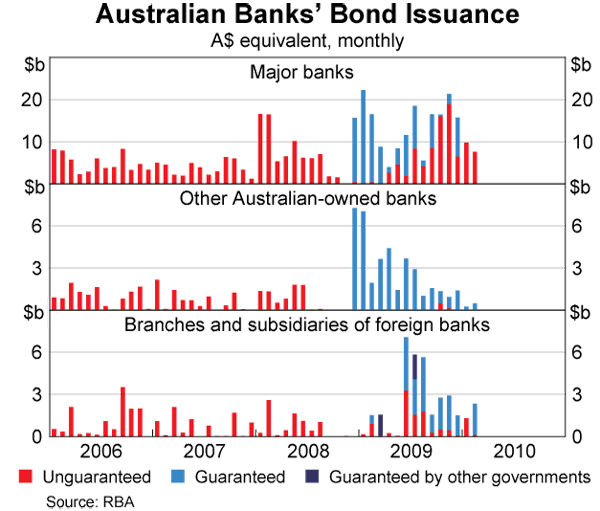
In 2009, the banks issued a record volume of bonds ($228 billion), almost double the issuance in 2008 and well above issuance in 2007 ($61 billion). The very strong issuance last year reflected balance sheet growth, refinancing and the banks increasing the duration of their wholesale funding liabilities.
Markets of Issuance
The Australian banks, particularly the major banks, have historically diversified their sources of funds by issuing bonds into a variety of markets and currencies. In this way they are able to tap a wider range of investors, enabling them to have more reliable access to markets as well as contributing to a lower cost of funds. Around 20 per cent of bonds were issued in the domestic market prior to the financial crisis, with the remaining 80 per cent issued in a range of overseas markets. The bulk of banks' offshore bond issuance was denominated in US dollars and euro, though the current stock of banks' bonds outstanding is denominated in at least 15 different currencies (Graph 3).[4]
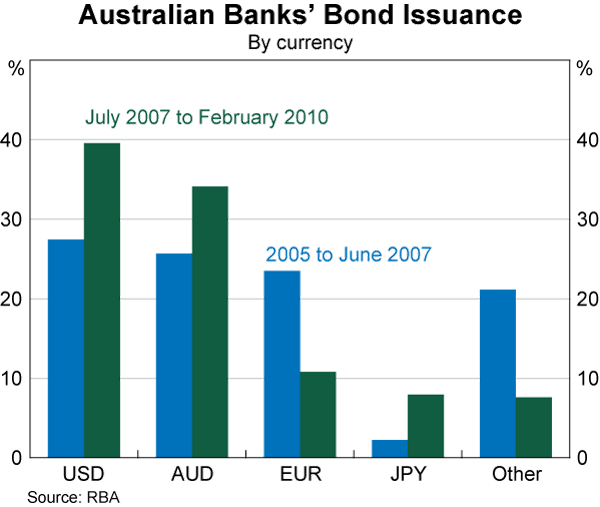
The Australian banks hedge almost all of their foreign currency bond issuance back into Australian dollars by undertaking interest rate and cross-currency swaps at the time of issuance, effectively raising Australian dollar funds.[5] The Australian banks tend to issue in markets where it is cheapest to borrow Australian dollar equivalent funds at that time. In this way, they take advantage of pricing differentials between alternative funding markets, using derivatives to manage the associated exchange rate risks.[6]
During the financial crisis, the banks continued to access many markets but increased the proportion issued in those markets that were less impaired and retained greater liquidity. While cost minimisation continued to influence the major banks' decisions about where to issue bonds – and whether to issue guaranteed or unguaranteed bonds – other factors such as funding diversification and the ability to issue larger or longer-maturity bonds became more important during the period of dislocation as investor demand for bank debt globally weakened. For example, at times the banks were prepared to pay a slightly higher spread in the US market where they could issue larger deals than in the domestic market. Nonetheless, price incentives saw the share of bonds issued domestically increase to around one-half following the collapse of Lehman Brothers, compared with one-quarter in the initial stages of the financial crisis, and one-fifth prior to the crisis. As unguaranteed offshore and onshore spreads have converged, the share of bonds issued onshore has returned to be around pre-crisis levels.
During the financial crisis, the banks issued a higher share of offshore bonds in US dollars and yen than they had historically, and conversely issued a lower share in euro. The major banks tapped the Samurai market – yen issuance into the Japanese market by non-residents – for the first time as they could issue bonds at a longer maturity (typically around five years) than they were able to do in most other markets at that time. The major banks also issued extendible bonds to target US money market funds (that can invest in securities of only relatively short maturities) and increased their use of private placements, particularly in the US domestic market.[7] The banks have issued guaranteed bonds both in the domestic and offshore markets, with Australian dollar and US dollar bonds accounting for the bulk of these, though other currencies have included yen, Swiss franc and pound sterling.
Bond Maturity
In the years leading up to the financial crisis, the Australian banks issued bonds mostly with maturities of 2 to 6 years, with an average of 5 years. With the onset of the financial crisis and the decline in risk tolerance, investors were less prepared to lock up funds for extended periods and so the distribution of bond maturities at issuance shifted toward shorter terms, with the average maturity shortened to around 3½ years (Graph 4). In some cases, at least initially, issuers also preferred to borrow at shorter terms rather than locking in high spreads. Of note, the major banks issued a sizeable amount of extendible bonds that had an initial maturity of 13 months and could be extended beyond that at the discretion of the investor. While these bonds had a ‘step-up’ structure, whereby the spread would increase by around 5–8 basis points each year if extended, most investors did not extend these bonds as the expected increase in bond spreads was greater. (This was in contrast to previous years, where, in an environment of narrowing spreads, investors had an incentive to extend the bonds.) In part reflecting issuance of extendible bonds, 25 per cent of bonds were issued with a maturity of 1–2 years, up from 6 per cent previously.
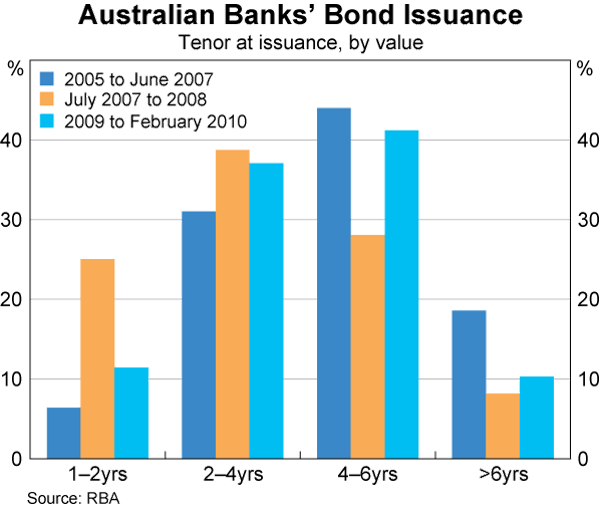
Initially, the Government guarantee enabled banks to issue bonds for larger amounts and for longer terms than unguaranteed securities. Much of the increase in bond maturities over 2009, however, reflects the ability of the major banks to issue unguaranteed debt at longer maturities as market conditions have improved, including beyond the five-year limit of the Guarantee Scheme. While the distribution of bond maturities at issuance has moved toward longer terms, it is not yet back to the patterns prevailing prior to the financial crisis. For example, around 50 per cent of bond issuance since 2009 was at terms of four years or more, up from 35 per cent in the initial stage of the financial crisis, though below the 65 per cent share previously. The average term of issues domestically remains below the pre-crisis average, though the average maturity of bonds issued offshore over the past few months is around the pre-crisis average. Overall, the average maturity of the stock of bank bonds outstanding is around 3¼ years, up from 2½ years in late 2008.
Pricing
As mentioned above, prior to the financial crisis, the major banks raised funds domestically or in various offshore markets depending on where it was most cost-effective to do so. It is possible to compare the costs incurred by the major banks, after hedging, from issuing 3-year bonds in A$ onshore and in US$ offshore, their main markets of issuance (Graph 5; the dots indicate the cost at issuance and the lines suggest where the bonds are trading in the secondary market, which provides a broad indication of the spread at which the major banks could issue in those markets).[8] Prior to mid 2007, spreads were relatively stable and there was no systematic difference in costs of issuing onshore or offshore; the spread to CGS at issuance was relatively stable and averaged 50 basis points onshore and offshore.
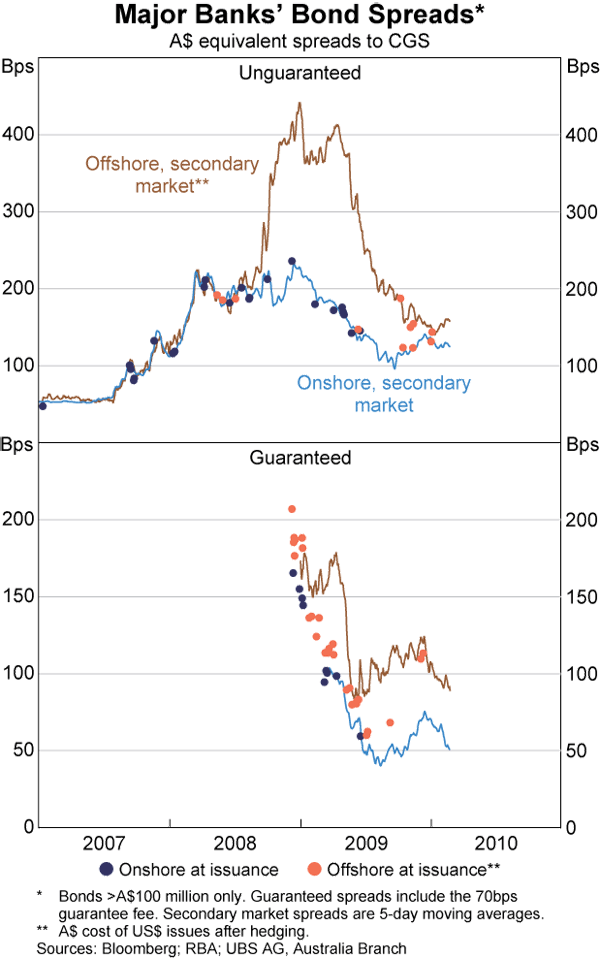
Consistent with the global reassessment of risk that marked the onset of the financial crisis, spreads widened from mid 2007. Markets globally, however, were similarly affected and the major banks continued to time their issuance to take advantage of differences in pricing across markets.
In late 2008 following the failure of Lehman Brothers, the cost of raising funds offshore (unguaranteed) increased sharply. The guarantee helped to alleviate some of these cost pressures, with guaranteed issuance initially cheaper both offshore and onshore (including the fee). Accordingly, the banks utilised the guarantee and increasingly tapped the onshore market during this period.
Increasing investor demand for unguaranteed debt in 2009 – both onshore and offshore – as market conditions improved, saw spreads on unguaranteed bonds narrow more sharply than on guaranteed bonds. As a result, unguaranteed debt became cheaper to issue than guaranteed debt for the major banks. Initially this was for shorter terms, and then for bonds up to five years (the limit of the Guarantee Scheme), notwithstanding some movement in the relative spread following the announcement of the cessation of the guarantee of wholesale funding. The costs of raising funds without the guarantee offshore and onshore converged as offshore funding markets became more settled.
The volatility in offshore funding costs during the financial crisis partly reflected sharp moves in the spreads on interest rate and cross-currency basis swaps, which the banks use to hedge their foreign exchange exposure (Graph 6).[9] While these markets tend to be relatively liquid during normal market conditions, the cost of hedging became less predictable and more expensive during the financial crisis; in previous years, these swap spreads were steady at around 5 basis points, whereas they have ranged up to 80 basis points more recently. With these costs varying day to day during the financial crisis, the banks timed their bond issuance to try to minimise their hedging costs (and overall issuance cost).
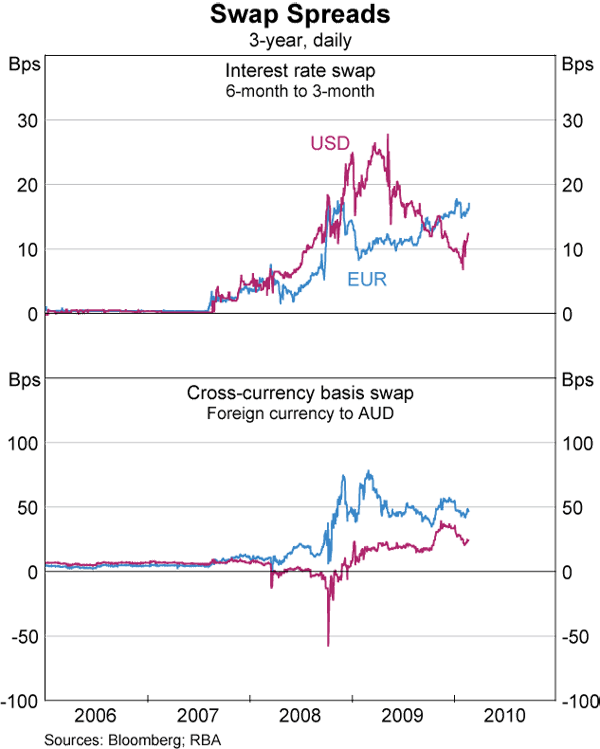
Conclusion
Bonds are an important source of funding for Australian banks, accounting for almost one-quarter of their liabilities. The financial crisis greatly affected term capital markets and accordingly the banks' bond issuance. Overall, the banks retained good access to bond markets, largely underpinned by their high profitability and strong credit ratings. At the height of the crisis, they were able to issue bonds, particularly in large volumes and for long terms, because of the Government guarantee. The guarantee also substantially reduced the cost of issuing debt, although this cost advantage gradually declined over time. The Australian banks have issued a record volume of bonds over the past couple of years, in part to lengthen the maturity of their wholesale liabilities.
Australian banks traditionally issued in a wide range of markets to take advantage of differences in cost as well as for funding diversification. While cost minimisation continued to be a significant driver of issuance patterns through the financial crisis, other factors – including market liquidity and the size and maturity of bonds that could be issued in particular markets – became more important. As spreads and risk aversion have declined, the large Australian banks have significantly scaled back their usage of the guarantee, and have been able to issue unguaranteed bonds cost-effectively since around the middle of 2009.
Footnotes
The authors are from Domestic Markets Department. [*]
For more information about banks' balance sheets, see Brown et al (2010). [1]
See Schwartz (2010). [2]
For a discussion of banks' profitability, see RBA (2009). [3]
The banks also issue A$ bonds offshore, though these typically make up only around 2–3 per cent of issuance. [4]
See D’Arcy, Shah Idil and Davis (2009). For an explanation of how the banks hedge foreign currency bonds, see Davies, Naughtin and Wong (2009). [5]
See RBA (2006). [6]
Extendible bonds typically have an initial maturity of 13 months and thereafter have a rolling maturity of 12 months, which is extendible at the option of the investor. [7]
The analysis here is somewhat simplified by focusing on the 3-year spectrum only; the banks also choose between issuing at different terms. Moreover, the decision of the market of issuance encompasses all other markets and currencies, not only the A$ and US$, though these are the main currencies of issuance. This analysis also does not take into account other costs, such as roadshow/marketing costs or legal costs that may differ across markets. [8]
Cross-currency swaps are used to convert foreign currency payments into A$ payments. Interest rate swaps are often used to hedge semi-annual bond coupon against 3-month LIBOR, since cross-currency swaps are typically benchmarked to 3-month LIBOR. [9]
References
Brown A, M Davies, D Fabbro and T Hanrick (2010), ‘Recent Developments in Banks' Funding Costs and Lending Rates’, RBA Bulletin, March, pp 35–44.
D’Arcy P, M Shah Idil and T Davis (2009), ‘Foreign Currency Exposure and Hedging in Australia’, RBA Bulletin, December, pp 1–10.
Davies M, C Naughtin and A Wong (2009), ‘The Impact of the Capital Market Turbulence on Banks' Funding Costs’, RBA Bulletin, June, pp 1–13.
RBA (2006), ‘Australian Banks' Global Bond Funding’, RBA Bulletin, August, pp 1–6.
RBA (2009), Financial Stability Review, September.
Schwartz C (2010), ‘The Australian Government Guarantee Scheme’, RBA Bulletin, March, pp 19–26.